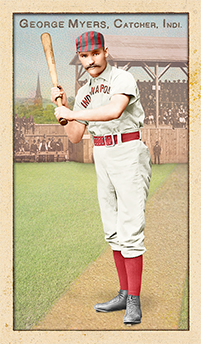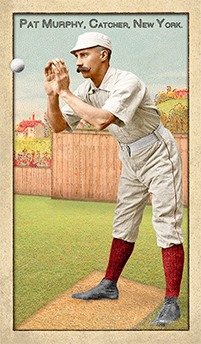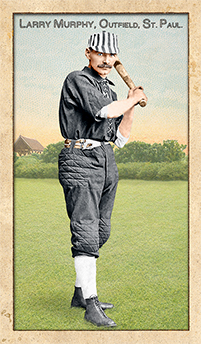
- Series: Beginnings: 1880's
- City: Indianapolis
- Team: Hoosiers (NL)
- League: National League
George D. Myers (1860-1926) was typical of the catchers of his day, a hard-working journeyman behind the plate and a weak hitter at it. His average over six years was a slim .203, but he was a steady backstop, valued by Buffalo and the Maroons/Hoosiers franchises. After 2 seasons with the Bisons, Myers moved to St. Louis in 1886 to the team that had started and ended the Union Association in ’84. Owner Henry Lucas had so stocked his Maroons as to make a mockery of competition. The league folded after a year and by 1886 John Brush bought the team and moved it to his Indianapolis stadium. Myers moved with the team and continued as the lead catcher, sharing duties with two others. Following his time in Indiana, Myers pursued minor league success with the Minneapolis Millers, then returned to his upstate New York roots with the Syracuse Stars and the Rochester Flour Cities through 1892.
- As a rookie in Buffalo, Myers cut his teeth under as fine a mentor as anyone in early baseball could hope for: “Orator Jim” O’Rourke who was in his final year as manager
- Although the Old Judge series features three known poses of George Myers, I could not find one of suitable quality for this project. This image is taken from an Old Judge proof taken at the same time as Meyers' other OJ images and may represent an as-of-yet undiscovered pose.

- Series: Beginnings: 1880's
- City: Washington, D.C.
- Team: Nationals
- League: National League
James Albert Myers (1863-1927) began in pro-ball for Muskegon and Winona in the Northwestern League before catching on with the Milwaukee Brewers of the Union Association, all in 1884. From there, Myers began a National League career, first with the Philadelphia Quakers and Kansas City Cowboys for a year each. He then played three years in Washington and three back in Philadelphia as the Quakers transitioned to Phillies, ending his baseball experience in 1891. The stocky second-baseman had a lifetime .246 average and never hit a home run. He was usually among the leaders in fielding chances and once led the league in errors.
- “Cod’s” best years as a regular were 1886 and ‘90, hitting a solid .277
- The latter year saw Myers swipe 44 bases and attain a .742 OPS
- Myer's uniform color in this card was changed from black to blue in August, 2017 to reflect recent reliable research conducted by Craig Brown and friends at Threads of Our Game. Six cards were previously released featuring a black uniform

- Series: Beginnings: 1880's
- City: New York
- Team: Giants
- League: National League
James J. Mutrie (1851-1938) was a giant among early baseball entrepreneurs. He may rightly be known as the father of New York baseball, is second only to Joe McCarthy in manager winning %, won pennants in two leagues, helped create (and won) the first true inter-league run-up to the “world series” and popularized the nickname for his Manhattan “Gothams” by referring to his burly lads as “my Giants!” Along the way, “Truthful James” (a wry sobriquet given by the immortal Father Henry Chadwick) stirred controversy at nearly every turn, risked all and in the end, lost. Yet he was beloved by his players and for decades was revered in the Big Apple as the man who truly brought the game to its biggest stage. He and partner John Day audaciously brought two new NY entries into the city: the AA’s Metropolitans and what would become the National League’s Polo Grounds-dwelling Giants who triumphed in the first two post-season tournaments. Done in by the Players’ League rebellion and ensuing financial pressures, Mutrie was forced from the game in 1892.
- Mutrie prospered by raiding AA players for his NY club and paid the price when his top talent defected a decade later to the PL
- Series: Beginnings: 1880's
- City: New York
- Team: Giants
- League: National League
Patrick J. Murphy (1857-1927) was a right-handed catcher for the New York Giants from 1887-1990. This Massachusetts native had a career batting average of .220 and hit one home run in the “Dead Ball” era. He played in one “world series” in 1888, going one for 10 and scoring a run in three games against the St Louis Browns. The Giants prevailed six games to four. The contest was marked by the great future Hall of Famer Tim Keefe’s four victories over the Browns.
- Murphy was a grizzled 30 years of age when he broke in with the Giants
- Murphy’s sole hit in the ’88 series was good for an RBI
- In 1889 Murphy’s salary was $1800
- Series: Beginnings: 1880's
- City: St. Paul
- Team: Apostles
- League: Western Association
Patrick Lawrence Murphy (1857-1911) played one year in the major leagues for the Washington Statesmen. The year was 1891, the first in the storied franchise that became the Senators. The American Association folded the next year giving Murphy the distinction of playing for the nation’s capital’s only entry in that league. Murphy batted left-handed and managed one HR and a .265 BA. Murphy came late to the big stage. He made his pro ball debut at age 31 with the St. Paul Apostles, moving over to the Minneapolis Millers in ’91 before joining the Statesmen. He ended his minor league tenure the following year, playing for four teams: the Chattanooga Chatts, the Indianapolis Hoosiers, the New Haven Nutmegs and the Buffalo Bisons.
- This Canadian late-comer to America’s game batted a modest .237 in his minor league play
- The Toronto native died in Indianapolis only 20 years after his brief time in MLB




